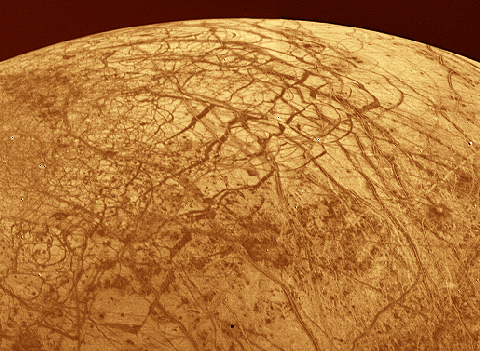Astronomy Picture of the Day
Discover the cosmos!
Each day a different image or photograph of our fascinating universe is
featured, along with a brief explanation written by a professional
astronomer.
August 13, 1996

Europa's Surface
Credit:
Voyager Project,
JPL,
NASA,
Copyright Calvin J. Hamilton
Explanation:
Voyager spacecraft images of
Europa's surface, like the one above,
are suggestive of sea ice on Earth.
The criss-crossing dark streaks
may indeed be cracks in its ice-covered surface
caused by Jupiter's tidal stresses accompanied by
the freezing and expansion of an
underlying layer of water.
This tantalizing prospect of
oceans of liquid water
beneath its frozen surface has helped make the
smallest of the Galilean moon's of Jupiter a planned focus of
the Galileo spacecraft's ongoing mission to explore the Jovian system.
New Europa images and results from the Galileo mission were
released today revealing details
which further suggest that Europa's icy surface was once - and may still
be - supported on slush or liquid water.
Tomorrow's picture: Galileo Explores Europa
| Archive
| Index
| Search
| Glossary
| Education
| About APOD |




Authors & editors:
Robert Nemiroff
(MTU) &
Jerry
Bonnell (USRA).
NASA Technical Rep.:
Sherri
Calvo.
Specific rights apply.
A service of:
LHEA
at
NASA/
GSFC




